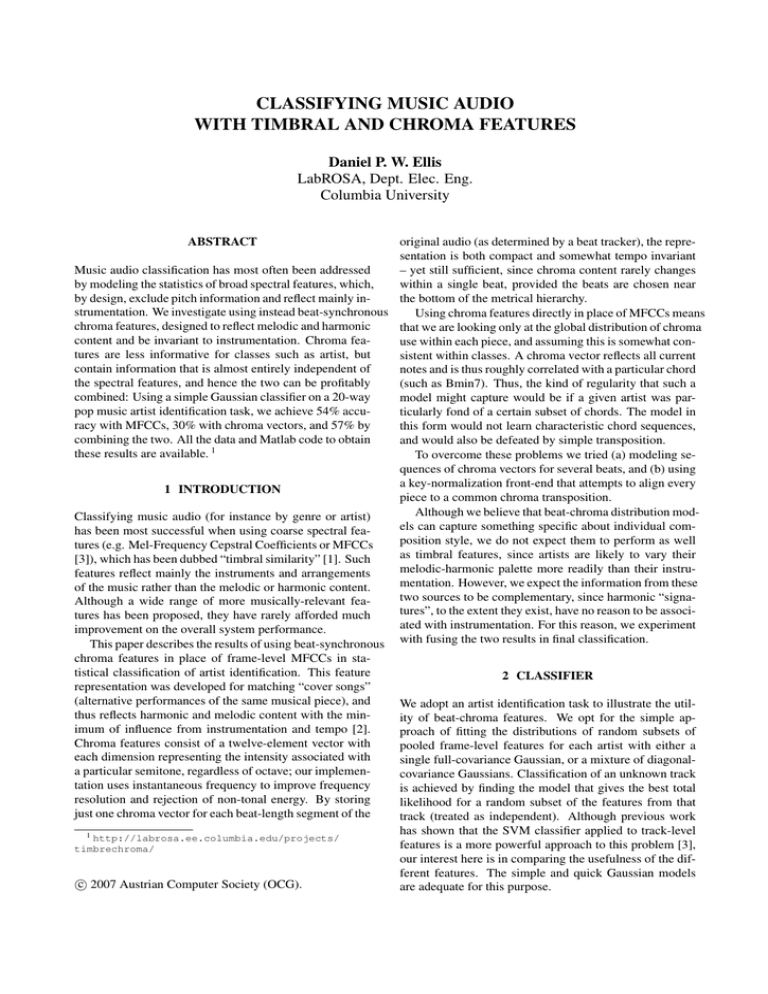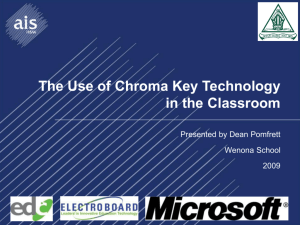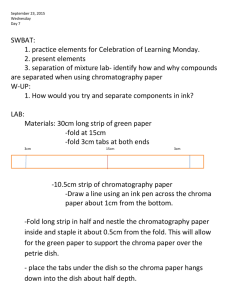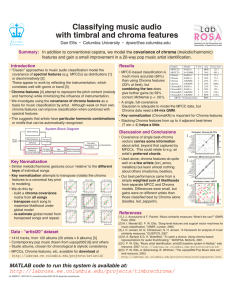CLASSIFYING MUSIC AUDIO WITH TIMBRAL AND CHROMA FEATURES Daniel P. W. Ellis
advertisement

CLASSIFYING MUSIC AUDIO WITH TIMBRAL AND CHROMA FEATURES Daniel P. W. Ellis LabROSA, Dept. Elec. Eng. Columbia University ABSTRACT original audio (as determined by a beat tracker), the representation is both compact and somewhat tempo invariant Music audio classification has most often been addressed – yet still sufficient, since chroma content rarely changes by modeling the statistics of broad spectral features, which, within a single beat, provided the beats are chosen near by design, exclude pitch information and reflect mainly inthe bottom of the metrical hierarchy. strumentation. We investigate using instead beat-synchronous Using chroma features directly in place of MFCCs means chroma features, designed to reflect melodic and harmonic that we are looking only at the global distribution of chroma content and be invariant to instrumentation. Chroma feause within each piece, and assuming this is somewhat contures are less informative for classes such as artist, but sistent within classes. A chroma vector reflects all current contain information that is almost entirely independent of notes and is thus roughly correlated with a particular chord the spectral features, and hence the two can be profitably (such as Bmin7). Thus, the kind of regularity that such a combined: Using a simple Gaussian classifier on a 20-way model might capture would be if a given artist was parpop music artist identification task, we achieve 54% accuticularly fond of a certain subset of chords. The model in racy with MFCCs, 30% with chroma vectors, and 57% by this form would not learn characteristic chord sequences, combining the two. All the data and Matlab code to obtain and would also be defeated by simple transposition. these results are available. 1 To overcome these problems we tried (a) modeling sequences of chroma vectors for several beats, and (b) using a key-normalization front-end that attempts to align every 1 INTRODUCTION piece to a common chroma transposition. Although we believe that beat-chroma distribution modClassifying music audio (for instance by genre or artist) els can capture something specific about individual comhas been most successful when using coarse spectral feaposition style, we do not expect them to perform as well tures (e.g. Mel-Frequency Cepstral Coefficients or MFCCs as timbral features, since artists are likely to vary their [3]), which has been dubbed “timbral similarity” [1]. Such melodic-harmonic palette more readily than their instrufeatures reflect mainly the instruments and arrangements mentation. However, we expect the information from these of the music rather than the melodic or harmonic content. two sources to be complementary, since harmonic “signaAlthough a wide range of more musically-relevant features”, to the extent they exist, have no reason to be associtures has been proposed, they have rarely afforded much ated with instrumentation. For this reason, we experiment improvement on the overall system performance. with fusing the two results in final classification. This paper describes the results of using beat-synchronous chroma features in place of frame-level MFCCs in statistical classification of artist identification. This feature 2 CLASSIFIER representation was developed for matching “cover songs” (alternative performances of the same musical piece), and We adopt an artist identification task to illustrate the utilthus reflects harmonic and melodic content with the minity of beat-chroma features. We opt for the simple apimum of influence from instrumentation and tempo [2]. proach of fitting the distributions of random subsets of Chroma features consist of a twelve-element vector with pooled frame-level features for each artist with either a each dimension representing the intensity associated with single full-covariance Gaussian, or a mixture of diagonala particular semitone, regardless of octave; our implemencovariance Gaussians. Classification of an unknown track tation uses instantaneous frequency to improve frequency is achieved by finding the model that gives the best total resolution and rejection of non-tonal energy. By storing likelihood for a random subset of the features from that just one chroma vector for each beat-length segment of the track (treated as independent). Although previous work has shown that the SVM classifier applied to track-level 1 http://labrosa.ee.columbia.edu/projects/ features is a more powerful approach to this problem [3], timbrechroma/ our interest here is in comparing the usefulness of the different features. The simple and quick Gaussian models c 2007 Austrian Computer Society (OCG). are adequate for this purpose. 3 KEY NORMALIZATION The goal of key normalization was to find a per-track rotation of the circular, 12-bin chroma representation that made all the data within each training class as similar as possible. To do this we first fit a single, full-covariance Gaussian to the chroma representation of first track in the class. Then the likelihood of each subsequent track was evaluated using this model under each of the 12 possible chroma rotations; the most likely rotation was retained. After one pass through the entire set, a new Gaussian was fit to all the tracks after applying the best rotations from the first pass. The search for the best rotations was repeated based on this new model, and the process iterated until no changes in rotations occurred. The final, global model was also used on test tracks to choose the best rotation for them prior to classification. Feature Model T win MFCC20 FullCov 1 MFCC20 64 GMM 1 Chroma FullCov 1 Chroma FullCov 4 Chroma 64GMM 1 Chroma 64GMM 4 ChromaKN FullCov 1 ChromaKN FullCov 4 ChromaKN 64GMM 1 ChromaKN 64GMM 4 MFCC + Chroma fusion Acc 56% 56% 14% 20% 25% 29% 23% 28% 32% 33% 59% Exec time 127 s 563 s 21 s 57 s 337 s 1060 s 70 s 197 s 516 s 1238 s Table 1. Artist identification accuracy. “T win” is the size of temporal context window. “FullCov” designates single, full-covariance Gaussian models. “ChromaKN” refers to per-track key-normalized chroma data. Execution times are per fold on a 1.8 GHz Xeon E5310 CPU. 4 DATA We collected and used a set of 1412 tracks, composed of six albums from each of 20 artists. It is based on the 18 artist set used on [3] (drawn from “uspop2002”) with some additions and enhancements. We used 6-fold testing, with five albums from each artist used for training and one for testing in each fold. For this test set, statistical significance at 5% requires a difference of just over 3% in classification accuracy (one-tailed binomial). Guessing the most common class gives a baseline accuracy of 6%. 5 EXPERIMENTS For both MFCC and beat-chroma features, we experimented with varying the number of frames used to train and test the models, and the number of Gaussians used to model the distributions. We used 20 MFCC coefficients including the zero’th, based on a 20-bin Mel spectrum extending to 8 kHz. For the beat-chroma features, we varied the number of temporally-adjacent frames modeled from 1 to 4, and with using key normalization. The results are summarized in table 1. We notice that MFCCs are intrinsically more useful than chroma features (as expected, since the instrumentation captured by MFCCs is well correlated with artist), that Gaussian mixture models are preferable for the chroma features (which are likely to be multimodal) but not for MFCCs, that key normalization gives a small but significant improvement, and that concatenating multiple beats into a single feature vector gives small but consistent advantages for the chroma features. 2 Fusing the best MFCC and Chroma systems (shown in bold in the table) based on a weighted sum of separate model likelihoods tuned on a small tuning subset, we see a statistically significant improvement that results from including chroma information. 2 This conclusion is reversed from the original and published version of this paper after a bug was found in the implementation of concatenating multiple beats. 6 CONCLUSIONS We have shown that the simple approach of modeling the distribution of per-beat chroma vectors very much as cepstral vectors have been modeled in the past is a viable approach for artist identification. Rotating the chroma vectors in order to transpose all pieces to a common tonal framework is necessary to realize the full benefits, and concatenating several frames appears to offer some advantage. Our future plans are to pursue the idea of modeling small fragments of beat-chroma representation to identify the most distinctive and discriminative fragments characteristic of each composer/artist. 7 ACKNOWLEDGEMENTS This work was supported by the Columbia Academic Quality Fund, and by the NSF under Grant No. IIS-0238301. Any opinions, findings, etc. are those of the authors and do not necessarily reflect the views of the NSF. 8 REFERENCES [1] Jean-Julien Aucouturier and Francois Pachet. Music similarity measures: What’s the use? In Proc. 3rd International Symposium on Music Information Retrieval ISMIR, Paris, 2002. [2] D. P. W. Ellis and G. Poliner. Identifying cover songs with chroma features and dynamic programming beat tracking. In Proc. ICASSP, pages IV–1429– 1432, Hawai’i, 2007. [3] M. I. Mandel and D. P. W. Ellis. Song-level features and support vector machines for music classification. In Proc. International Conference on Music Information Retrieval ISMIR, pages 594–599, London, Sep 2005.





